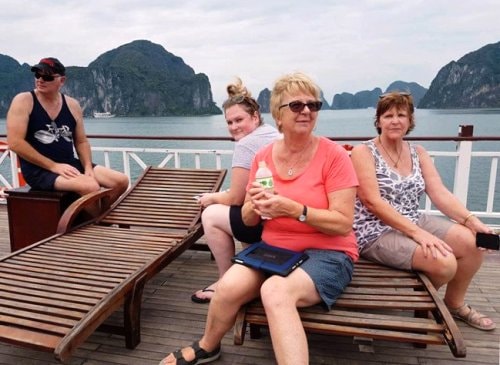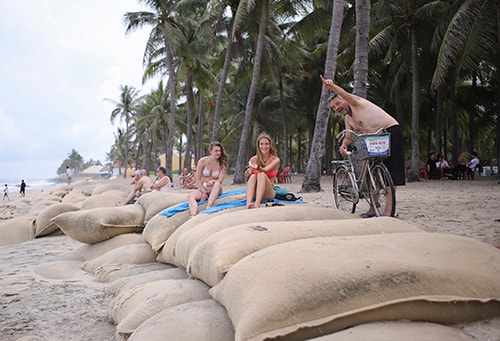Reasons why international tourists do not return to Vietnam
According to Joe - an Australian tourist, Thailand is more attractive than Vietnam because it has thousands of high-end beach resorts that make many people want to come back.
Like many tourists coming to Vietnam, Jorn (from Norway, has explored 58 countries) spent nearly a month exploring the S-shaped strip of land. Although very impressed with Vietnam because of its cheap prices, delicious food, easy travel, and diverse culture, last year Jorn shared on his blog the reason for not coming back here: Tourist traps.
A common situation he encountered was when the driver cheated with the meter running twice as fast as normal. When he asked for the fare, the two sides agreed on 80 (that is 80,000 VND or 4 USD - Jorn explained), but when they arrived, the driver asked for 80 USD. On a bus trip in Vietnam, the assistant driver charged him and his girlfriend 60,000 VND each, while the others only had to pay 40,000 VND. Although the amount was not much, both decided to get off the bus because they felt they had been cheated.
This feeling came to Jorn and his girlfriend more than once or twice. According to Jorn, that is one of the reasons why the rate of tourists returning to Vietnam is much lower than that of neighboring Thailand.
According to the Pacific Asia Tourism Association, the rate of visitors returning to Vietnam is about 10-40%, while in Thailand this rate is up to 80%.
Bad reputation spreads easily.
When searching for the phrase "never return to Vietnam", Google returns more than 100 million results in 0.51 seconds. Among them, it is not difficult to read complaints similar to Jorn's.
Tim Pile, writer ofSCMP, said that theft, traffic congestion, poor food hygiene, and rude taxi drivers are reasons why customers do not want to return. Tim cited the case of an American tourist who was attacked and robbed in Ho Chi Minh City in September 2017, but the tourist hotline was not staffed outside of business hours.
Share onQuoraJoe Bird, a tourist from Australia, gave several reasons why the rate of visitors returning to Vietnam is not as high as Thailand. One is that Vietnam is not an international transit hub. It will be difficult for you to get to your desired destination if you go through Hanoi or Ho Chi Minh City. This is different from Bangkok (Thailand), Kuala Lumpur (Malaysia), Singapore or Dubai, where Joe can easily fly directly to many places in the world.
Second, if you want to come to Vietnam, guests from many countriesmust apply for a visa in advance. They can go through the procedures to visit Vietnam once, but in the following trips, they will prioritize countries that exempt visas or issue visas at border gates, which are much more convenient. Joe also mentioned awareness. Because there was a time when wherever he went, he heard people mention Vietnam - a place that must be visited once in a lifetime. However, when he researched carefully, Joe saw a wave of criticism from bloggers, telling about their experiences of being scammed and solicited when traveling.
At a press conference about the "Australian tourist disappointed when buying a Ha Long tour" incident in May, the then General Director of the Vietnam National Administration of Tourism, Nguyen Van Tuan, emphasized that just one scandal would affect the image of Vietnamese tourism because this information spreads very quickly on social networks and is very difficult to recover.
|
A group of Australian tourists were upset when they bought a Ha Long cruise tour but the actual service quality was not as advertised by the company, the ship picked up passengers in Cat Ba, Hai Phong. Photo:Lynne Ryan. |
With security, safety, food hygiene... becoming a fear for tourists, Mr. Vu The Binh - Vice President of Vietnam Tourism Association, said that it is not difficult to solve if there is a specific person responsible for this problem.
Only meets curious and exploratory guests
Mr. Binh said that returning guests often fall into the group of resort, shopping and business (MICE tourism). Typically in Southeast Asia, Thailand is a shopping and resort paradise. Possessing many commercial centers, Singapore is also a financial center, making guests return many times for work.
Meanwhile, Vietnam tourism is currently mainly about exploration, so it attracts curious tourists. "Because of the need to explore, they go to this place today, and to another country tomorrow. If the trip is not satisfactory, they will not come back. The number of tourists exploring Vietnam is very large, that is why the rate of return visitors is not high," Mr. Binh pointed out.
The Vice President of the Tourism Association said that if the service and advertising are good, Vietnam can still attract tourists without worrying about the number of returning visitors in the near future, 3-5 years from now. Because 15-17 million international visitors this year is not a large number compared to other countries in the region, while Vietnam still has many attractive places for tourists to continue to explore.
|
Hoi An is one of the most popular destinations for foreign tourists in Vietnam. Photo:Nguyen Dong. |
However, in the long term, when tourist attractions in Vietnam are no longer novel, resorts, shopping and MICE tourism centers need to develop to replace them.
Vietnam has the conditions to develop resort tourism because it has many beautiful beaches. "If we turn beaches into complete resorts, not just places to sleep, we will have many returning guests," said Mr. Binh.
Shopping services are considered the weakest product of Vietnam tourism. According to the General Department of Tourism, international visitors spend only 15-18% of their total expenditure on shopping. While in Thailand, Singapore, Japan, and Hong Kong, this ratio accounts for nearly half.
According to Mr. Binh, the issue of developing special goods to sell to tourists must become a priority in the next 5 years, if we want to increase the rate of returning visitors, in addition to forming financial, commercial and conference centers to compete with countries in the region.


